là một chương trình vẽ vector, thường được sử dụng để vẽ hình minh hoạ, hoạt hình, biểu đồ, đồ thị. Adobe Illustrator được dùng để thiết kế : như thiết kế những sản phẩm trong ngành thiết kế quảng cáo, thiết kế in ấn, thiết kế logo, thiết kế bản hiệu, thiết kế thời trang, thiết kế thiệp mời, Tạo các sản phẩm tờ rơi, Cataloge, Card Visit, Broucher, Profile,vẽ hoạt hình, tích hợp chuyển động cho Flash...Adobe Illustrator ưu diểm là dễ dàng thay đổi và trao đổi dữ liệu ,kích thước file nhẹ, dễ dàng tương thích với Photoshop, Corel Draw, và hỗ trợ in ấn rất tốt.
Hôm nay, trung tâm TIN HỌC KEY xin giới thiệu đến các bạn một hệ thống bài tập thực hành vẽ các đối tượng trong Adobe illustrator (Ai) (phiên bản tiếng anh, theo: vectips.com) có hướng dẫn chi tiết các bước thực hiện cụ thể để các bạn dễ dàng thực hành theo. Hôm nay chúng ta sẽ học bài 10: One Tool to Create a 3D Button Vector? Done. Hy vọng hệ thống bài học này sẽ mang lại cho bạn những kiến thức hữu ích trong quá trình bạn học Adobe illustrator (Ai).
Chúc các bạn thành công!
One Tool to Create a 3D Button Vector? Done
Final Image
As always, below is the final image that we’ll be creating. The great thing about this 3D button vector tutorial is that it can be customized to create so many kinds and shapes of buttons. Below are just a few examples.
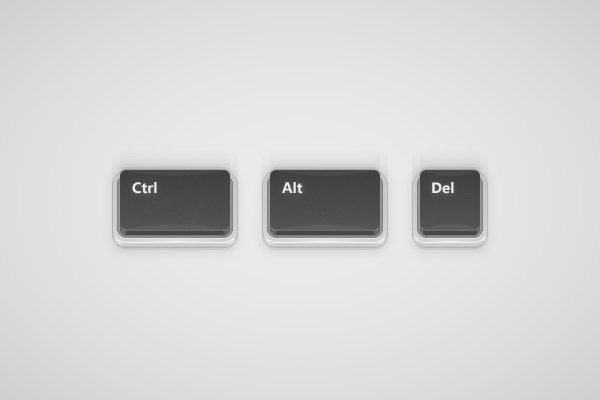
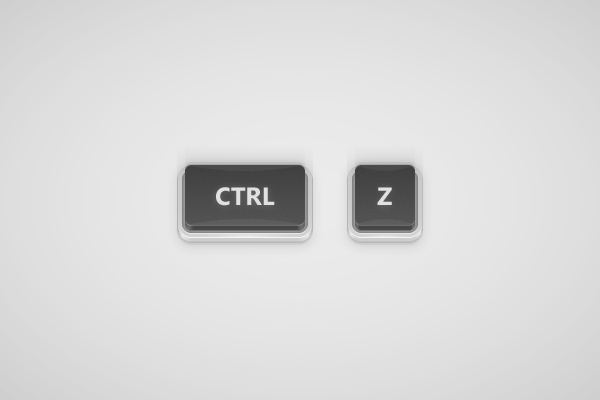
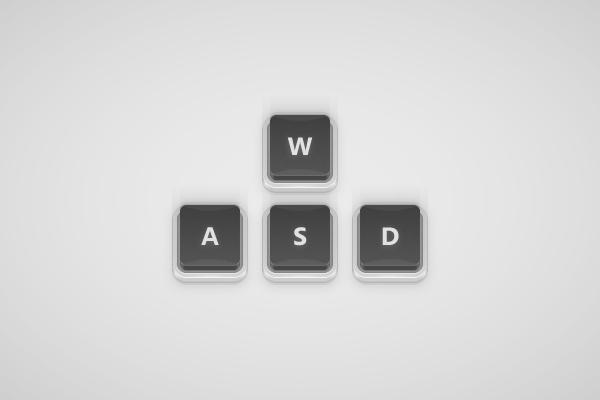
Step 1
Hit CTRL + N to create a new document. Select Pixels from the Units drop-down menu, enter 600 in the width and height boxes then click on theAdvanced button. Select RGB, Screen (72ppi) and make sure that the Align New Objects to Pixel Grid box is unchecked before you click OK. Enable the Grid (View > Show Grid) and the Snap to Grid (View > Snap to Grid). You will need a grid every 5px, so simply go to Edit > Preferences > Guides > Grid, enter 5 in the Gridline every box and 1 in the Subdivisions box. Try not to get discouraged by all that grid, it will ease your work and keep in mind that you can easily enable or disable it using the Control + “ keyboard shortcut. You should also open the Info panel (Window > Info) for a live preview with the size and position of your shapes. Do not forget to set the unit of measurement to pixels from Edit > Preferences > Units > General. All these options will significantly increase your work speed.
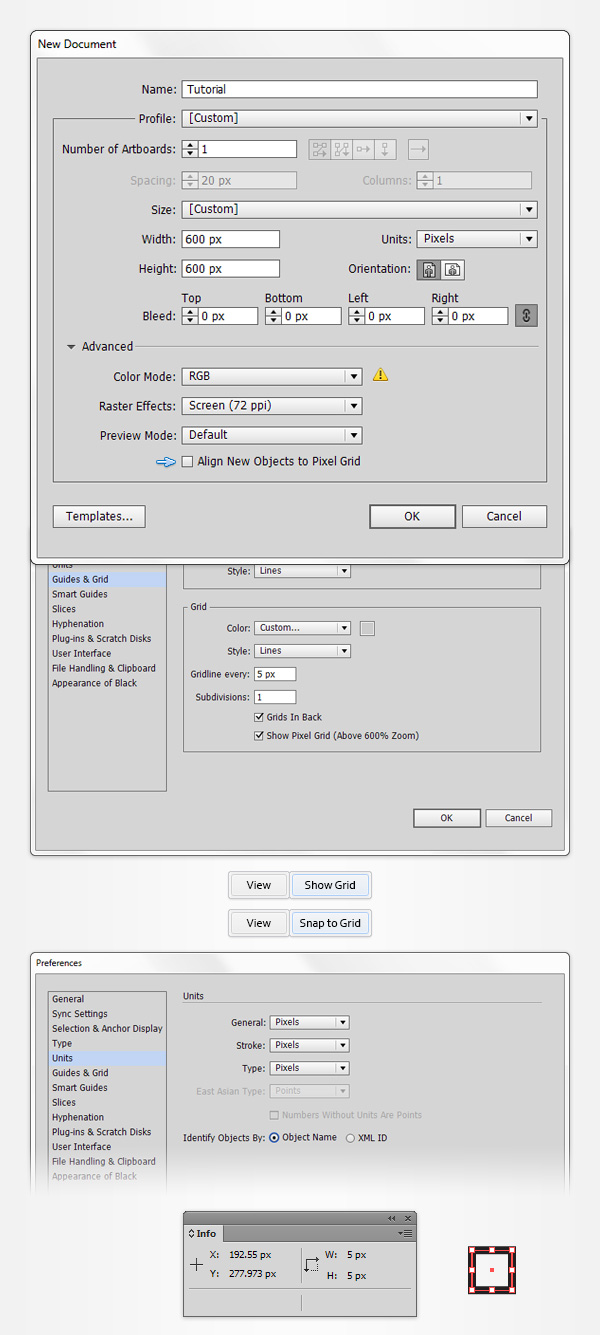
Step 2
The next step to creating these 3D button vectors is to pick the Rectangle Tool (M), focus on your artboard and create a 110 x 60px shape. Make sure that your rectangle does not have a color set for the stroke, open the Gradient panel (Window > Gradient) and simply click on the gradient thumbnail to add the default black to white linear gradient. Keep focusing on your Gradient panel, set the Angle at -90 degrees then move to the gradient colors. Select the right slider and set the color at R=95 G=95 B=95 then select the left slider, set the color at R=75 G=75 B=75.
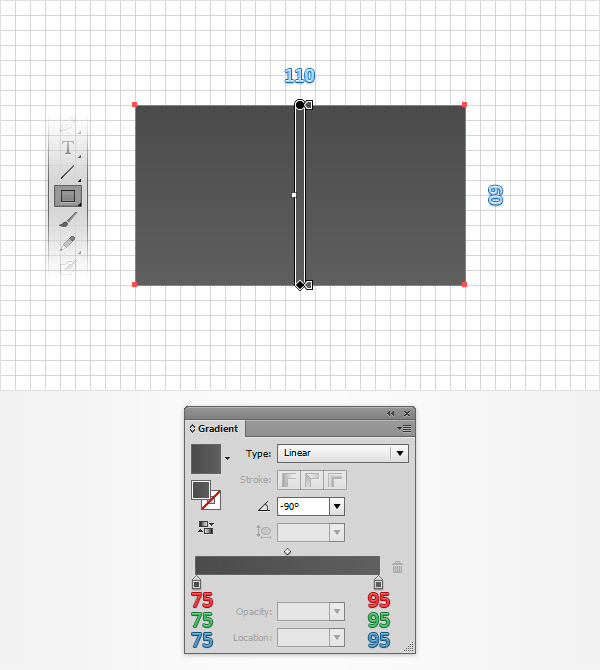
Step 3
Make sure that your rectangle is still selected and open the Appearance panel (Window > Appearance). Select the existing fill and go to Effect > Stylize > Drop Shadow. Enter the properties shown in the top, left window (in the following image), click OK then add the other three Drop Shadoweffects shown in the following image. Starting to see the beginnings of a 3D button vector!
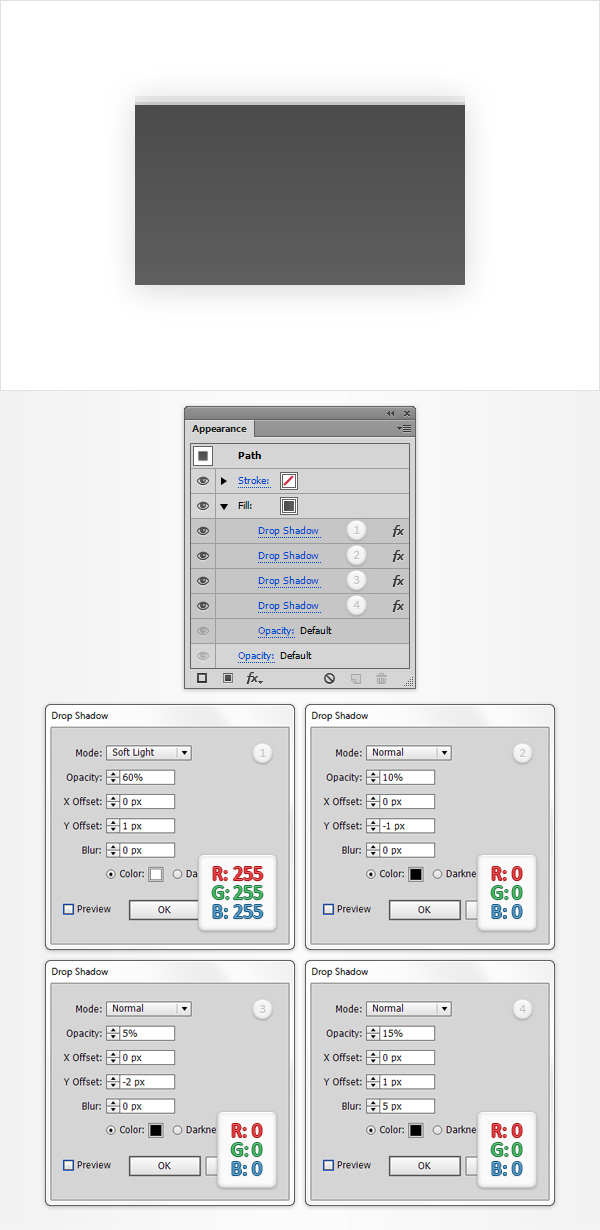
Step 4
Make sure that your rectangle is still selected, focus on the Appearance panel and add a second fill using the Add New Fill button (pointed by the blue circle in the following image). Select the new fill, replace the existing linear gradient with the one shown in the following image and go toEffect > Warp > Bulge. Enter the properties shown in the following image and click OK.
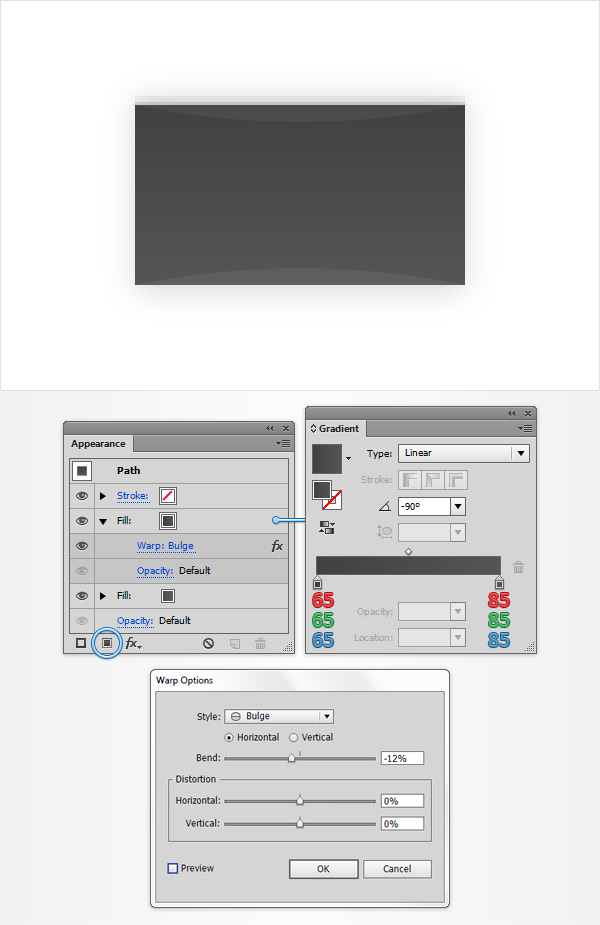
Step 5
Make sure that your rectangle is still selected, focus on the Appearance panel and add a third fill using that same Add New Fill button. Select the new fill, replace the existing linear gradient with black (R=0 G=0 B=0) and go to Effect >Path > Offset Path. Enter a -1px Offset, click OK and go toEffect > Artistic > Film Grain. Enter the attributes shown in the following image and click OK. Return to the Appearance panel and simply click on that little arrow icon that stands for your black fill so that you can see the applied effects and attributes. Simply click on the “Opacity” piece of text that stands for your black fill to open the fly-out Transparency panel. Lower the Opacity to 4% and change the Blending Mode to Multiply.

Step 6
Next step in creating this 3D button vector is to make sure that your rectangle is still selected, add a fourth fill and drag it in the bottom of theAppearance panel. Make sure that it stays selected, add the linear gradient shown in the following image, lower its Opacity to 10% and go to Effect > Distort > Transform. Enter the properties shown in the following image and click OK. The white number from the Gradient panel stands forLocation percentage while the yellow one stands for Opacity percentage. This simply means that you need to select that gradient slider, focus on the Opacity box (from the Gradient panel) and lower it to 0% then focus on the Location box and set it at 90%.

Step 7
Make sure that your rectangle is still selected, add a fifth fill and drag it in the bottom of the Appearance panel. Make sure that it stays selected, add the linear gradient shown in the following image and go to Effect > Distort & Transform > Transform. Focus on the Move section drag the Verticalslider at 5px, click OK and go to Effect > Stylize > Drop Shadow. Enter the properties shown in the following image and click OK.

Step 8
Make sure that your rectangle is still selected, add a sixth fill and drag it in the bottom of the Appearance panel. Make sure that it stays selected, set the color at R=175 G=175 B=175 and go to Effect > Path > Offset Path. Enter a 3px Offset, click OK and go to Effect > Distort & Transform > Transform. Enter the properties shown in the following image, make sure that you check the middle, bottom reference point (pointed by the blue circle in the following image) and click OK.
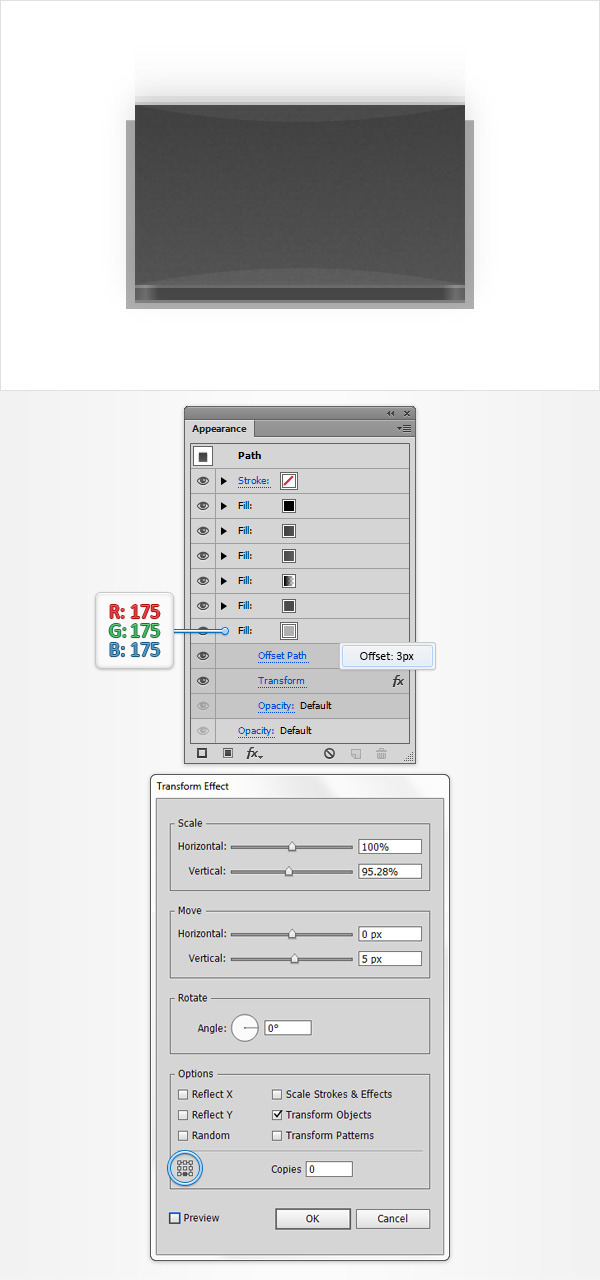
Step 9
Make sure that your rectangle is still selected, reselect the bottom fill and go to Effect > Stylize > Inner Glow. Enter the properties shown in the following image, click OK and go to Effect > Stylize > Drop Shadow. Enter the attributes shown below and click OK.

Step 10
Make sure that your rectangle is still selected, add a seventh fill and drag it in the bottom of the Appearance panel. Make sure that it stays selected, add the linear gradient shown in the following image and go to Effect > Path > Offset Path. Enter an 8px Offset, click OK and go to Effect > Distort & Transform > Transform. Focus on the Move section, drag the Vertical slider at 9px and click OK.
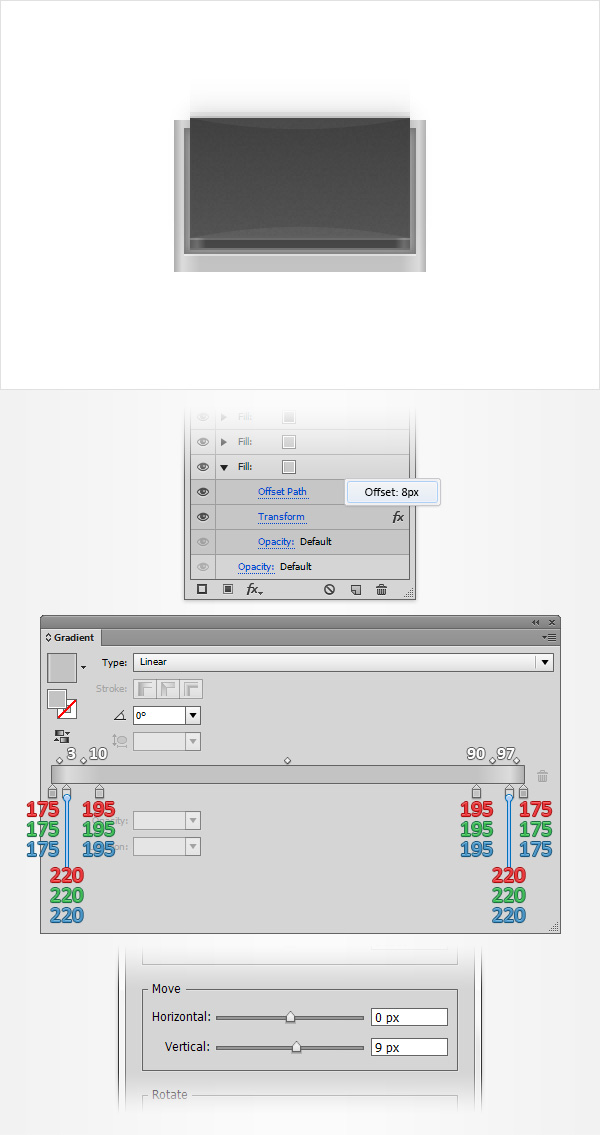
NHẤP VÀO ĐÂY để xem các bước tiếp theo .....
Trung Tâm TIN HỌC KEY
ĐC: 203-205 Lê Trọng Tấn - Sơn Kỳ - Tân Phú - TPHCM
ĐT: (028) 22 152 521
